Photographic Proof: Unicorns
the True Story
of the Unicorn Photos
Copyright 2011 by Nenah Sylver
[with thanks to the creators of the fantasy unicorn images--
please contact me so I can credit you]
To some, this story might seem fantastic (as in "fantasy")—just as Royal Rife's discovery, 80 years ago, that cancer could be cured by certain frequencies transmitted by an electromagnetic field was regarded as fantasy. When creating this page, it occurred to me that in making this story public, my credibility as a serious researcher and science/medical writer might take a beating. So I had to decide: should I post these photos or not?
The answer could only be yes, because the reality and the photos are too good not to share. Some people might be skeptical; but I know the truth of what I saw and experienced. Hopefully, you will too, once you read my essay and view the following photos with an open mind. By the way, the camera I used was a Canon film camera, not a digital one. I still have the negatives.
First, historical images of mythic unicorns
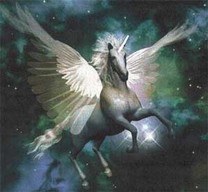
Sometimes, horse unicorns were
depicted with wings.
The mythological horse Pegasus
had wings and could fly,
but did not have a horn.
Some modern images
combine the winged horse
with a horned horse.
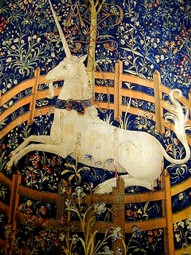
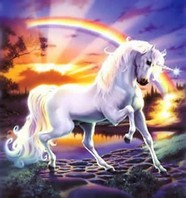
Historically, unicorns were
often perceived as horses.
Horses are so graceful,
beautiful and intelligent,
it's easy to see why people
would make drawings,
paintings and sculptures
of horse unicorns.
Now, the story of the real one
Unicorns have been beloved throughout the ages. They are usually depicted as horses (and very occasionally, winged horses), usually white, with a single horn in the center of the forehead. Some of you might be surprised to learn that unicorns are real, though not in the sense that most people may think. I have personal experience with one of these animals, which you may find interesting. I promise you that all the photos following this narrative are real and not retouched—I don’t even know how to doctor photos!
It all started a little over 20 years ago, when I was acquainted with Oberon Zell-Ravenheart (whom I knew at that time as Otter Zell), publisher of the magazine Green Egg. He and I had a lengthy discussion one day about unicorns. With his background in anthropology, he had conducted extensive research on unicorns and was able to produce several. Just exactly how did this come about?
Fascinated as to how unicorns became so entrenched in popular culture, and wondering if there was some reality to the mythical beast, he’d been visiting the Cloisters Museum in New York City when the famous unicorn tapestry caught his eye. He recognized the animal with one horn in the tapestry as a goat. He then realized that all animals historically depicted as unicorns—except for horses, a relatively modern “unicorn phenomenon”—have horns. All unicorns, therefore, were males, since the males grow horns. (Theoretically, you could create a unicorn from a female reindeer, since the females have horns all year round. But that's another story.)
Otter started with a baby male goat. In all newborn mammals, the skull has soft spot on top until the skull hardens. (Even in human adults, you can feel this tender spot at the top of your head.) Every day, a few times a day, Otter would massage the top of the skull with a special salve (ingredients undisclosed). The top of the skull contains the cells that will eventually grow into horns. Otter massaged the skull in such a way that he brought all the cells from either side of the center to the exact middle of the forehead. When the goat matured and the time came for horns to sprout, lo and behold! One horn grew, not two. And the horn was smack in the center of the forehead.
Otter hypothesized that the shape of the skull had to change to support the weight of the single, thick, heavy center horn rather than the usual two thinner, lighter horns. The increased cranial space allowed for a larger brain, thus increasing the animal’s intelligence. In his experience, all of the unicorn goats he had helped develop were smarter than their “normal” brothers.
End of theory, and now for the experiential part. I had the opportunity to meet one of these goats in person when I visited Otter a couple of years later, sometime in the 1990s. My partner and I took lots of pictures of the unicorn goat, who was quite loveable and friendly. We petted him and examined him from all angles (except the rear end, which I felt was not relevant to my research). There was absolutely no deceit that I could detect. The photos that follow are real, taken with an old-fashioned non-digital camera, and they are not retouched.
(By the way, the last time I looked, Wikipedia briefly mentioned unicorns in connection to Zell-Ravenheart. But its statement that Otter’s unicorn was created by “minor surgery to the horns of a goat” is not true; the method was as I described above.)
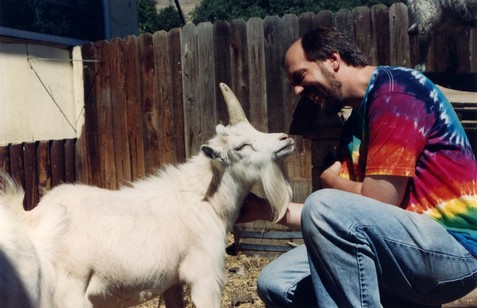
Paul with Goat Unicorn. We took lots of pictures from many angles so you can see that the horn is single, in the center of the forehead, and is truly part of the animal.
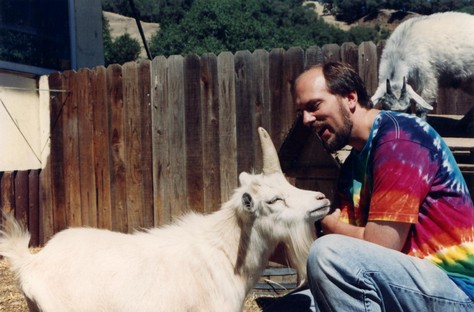
Goats are friendly animals, especially if they have had regular contact with humans from birth. Note the regular, non-unicorn goat standing on top of one of the goat houses behind Paul.
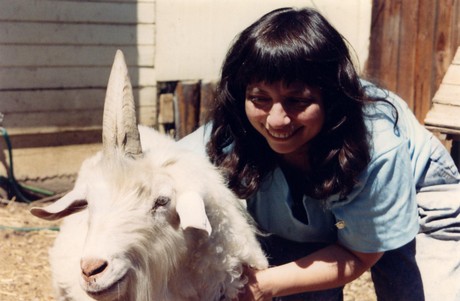
This is me, a couple of decades ago. (Sigh. I wish my hair today was as shiny and dark as it was then.) If you look closely, you can see a vertical seam running down the center of the one large horn, a structure created from the fusion of two smaller horns into one.
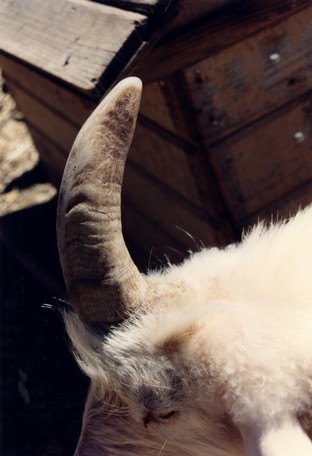
I remember how hard and heavy that one large horn felt. Two smaller horns are substantial enough—but what power and heft were in the single, two-horns-in-one combined! It’s not a hat, glued on or implanted, it’s real.
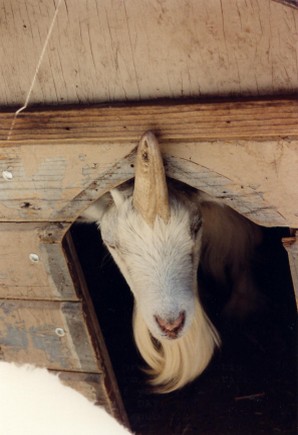
You can see the single horn highlighted against the goat house. Again, note the vertical seam in the center of the horn.
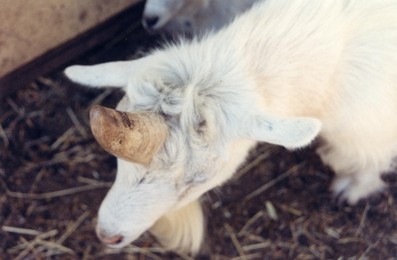
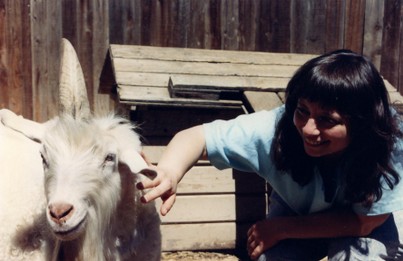
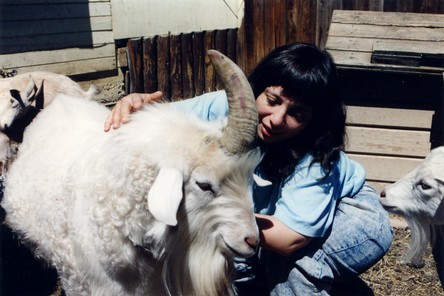
Since in the very formation of his horn as a baby Goat Unicorn was handled a lot by humans, he became super friendly as an adult, and amazingly calm.
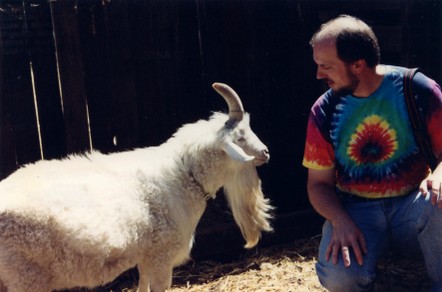
Goat Unicorn had quite a lovely beard, typical of male goats. (Paul had a nice beard too.)

Paul and Goat Unicorn, communing. Both have a sweet expression on their face.
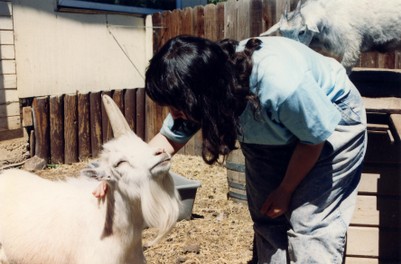
Another sweet expression on Goat Unicorn’s face.
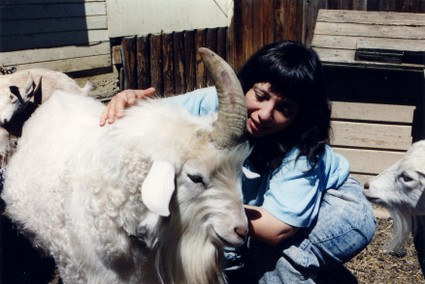
Goat Unicorn lived with several other goats. At the right is the head of a non-unicorn goat, also quite friendly.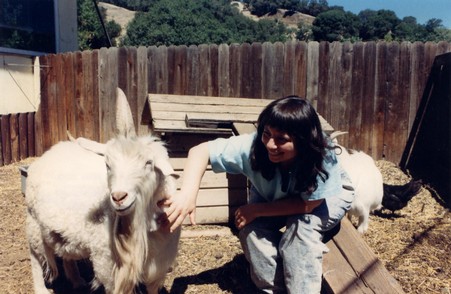
You can see the horns of the non-unicorn goat sticking up behind my left shoulder.
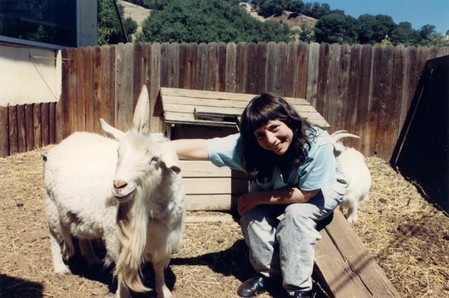
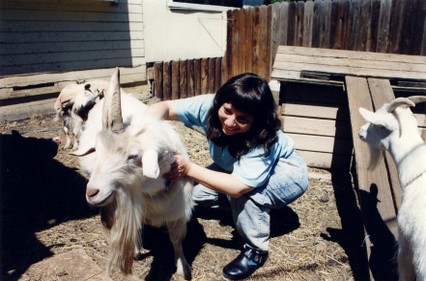
Goats are curious animals. As Goat Unicorn and I continued to commune, the other goats stepped out to see what was going on.
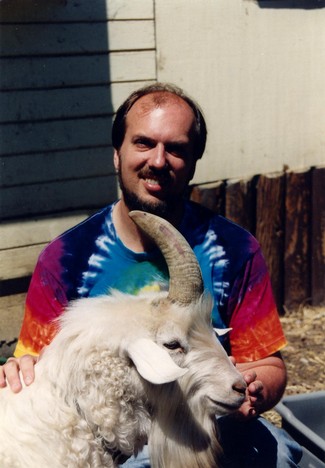
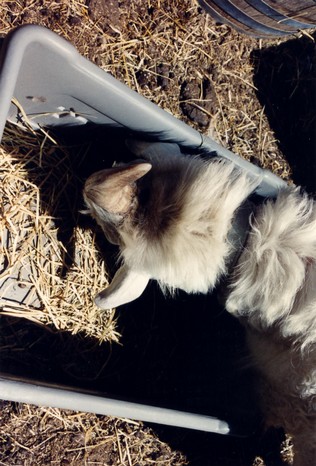
Another view of the horn.
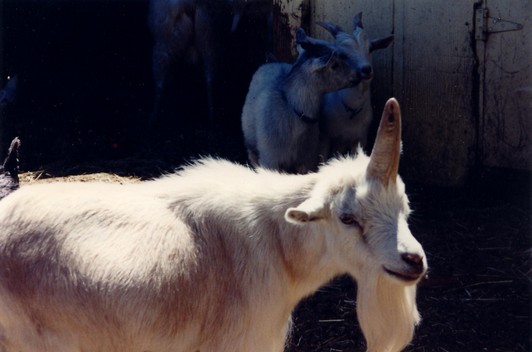
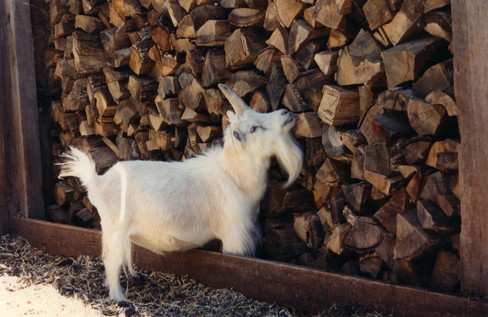
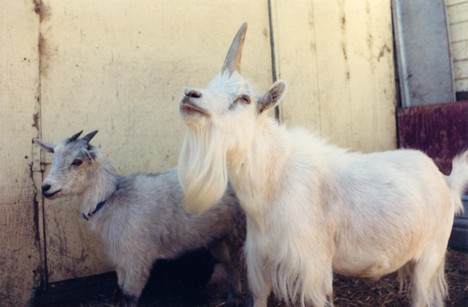
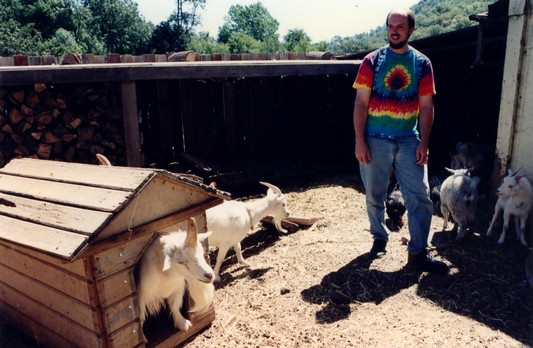
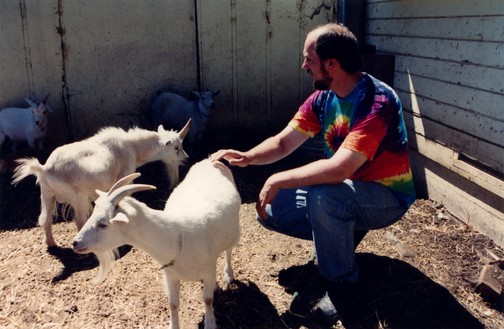
I think that when you live in a city and don’t have contact with many animals, you miss a special connection to nature, and thus to part of yourself. That’s why so many people have dogs and cats.
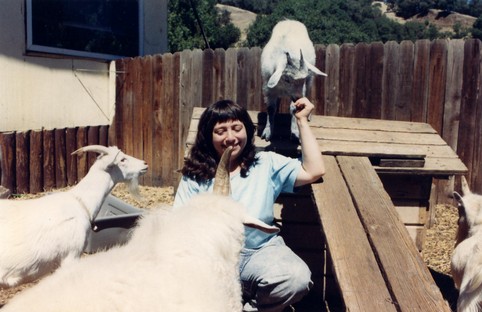
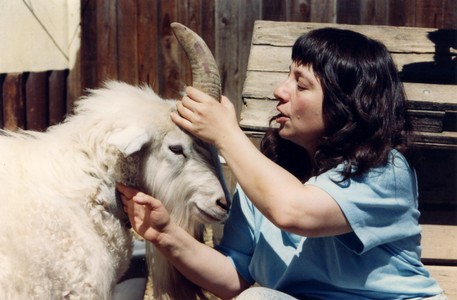
Goat Unicorn was so patient, letting me touch his horn like that!
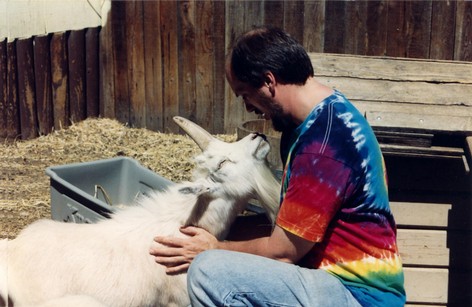
True love (on both sides), don’t you think?
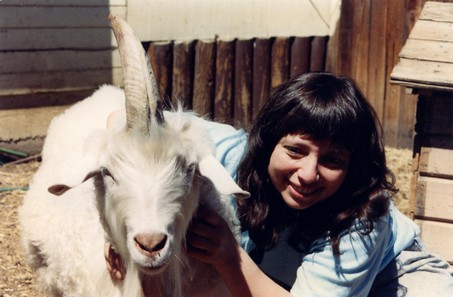
I think that Goat Unicorn would have posed for hours if we’d asked him to!
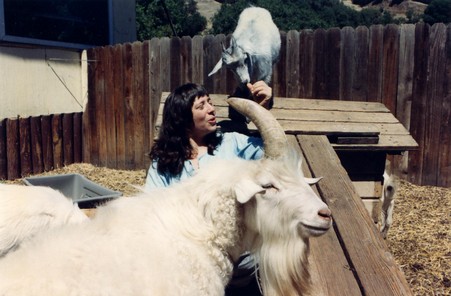
Goats are highly social creatures. In fact, there are few animals that are solitary. It’s important for animals to have company—especially of their own kind—because (like humans) they can get lonely.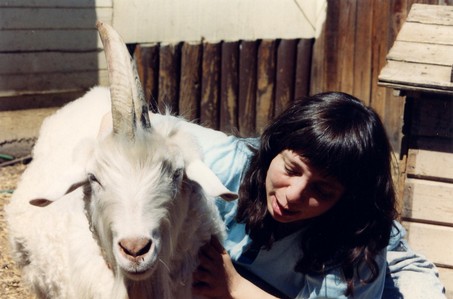
There’s an expression that people choose dogs that look like them—and there are photos all over the Internet to prove it. Here, I think I’m starting to look like the goat! Or is he starting to look like me?
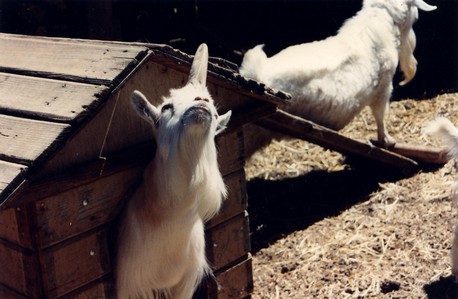
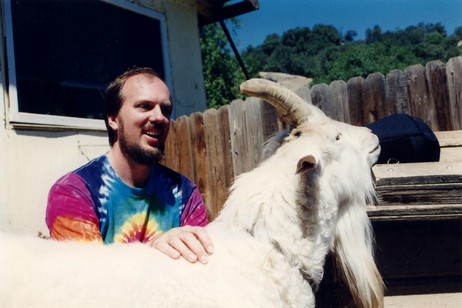
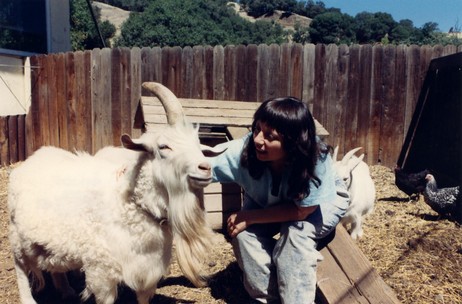
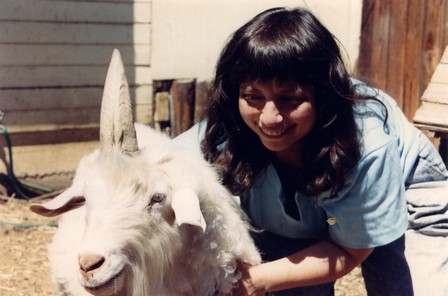
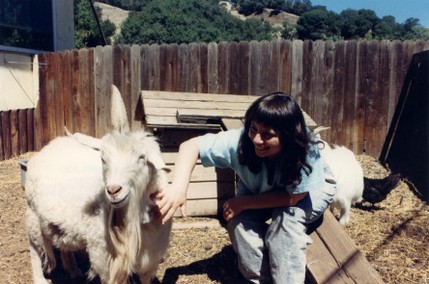
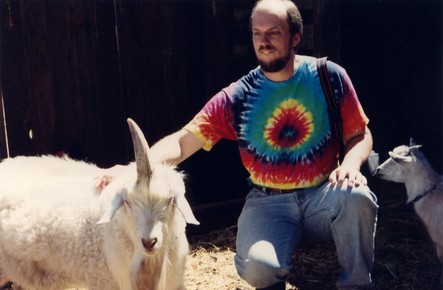
Goat Unicorn is a truly beautiful animal, inside and out.
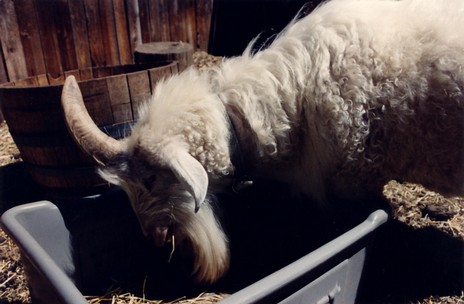
Even unusual beings must take time out to eat.
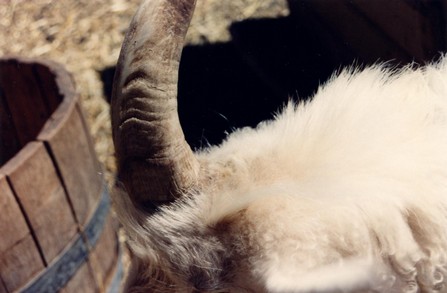
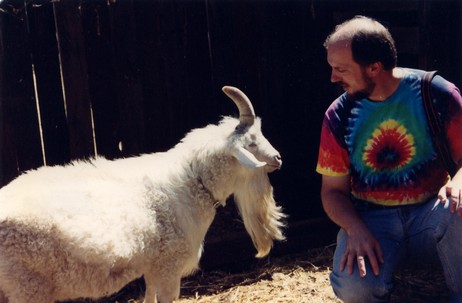
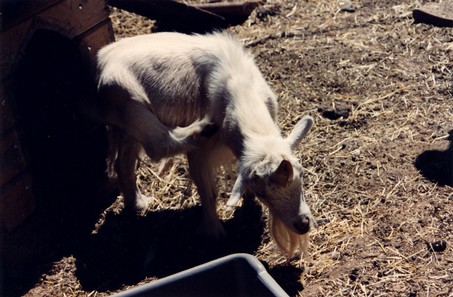
Even Goat Unicorns must scratch.
One more thing, before I close. I was very impressed that Goat Unicorn wasn’t put on display like someone in a freak show, but was living in peace and happiness with his fellow goats.
I hope you have enjoyed these photos. Feel free to send people to this section of my website. With all the stressors in these challenging times, I think we could all use a little real magic in our lives. Kind of like the frequency therapy of Royal Raymond Rife! Except, if you read through my website, the frequency therapy developed by Rife is based on solid science. (As is the creation of true unicorns.)
Until later,
Nenah Sylver

